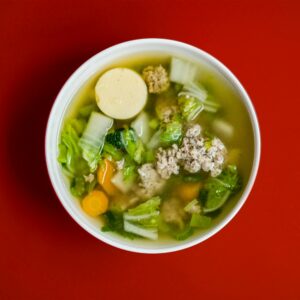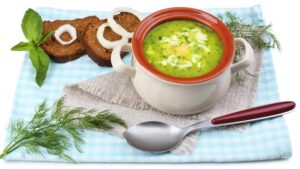Vegetable Soup, also known as Veg Soup, is a savory and nutritious dish made primarily from a medley of vegetables, herbs, spices, and sometimes grains or legumes, simmered together to create a flavorful and wholesome broth. It serves as a versatile and comforting meal enjoyed worldwide, offering a wide array of taste profiles and nutritional benefits.

Key Components:
Assorted Vegetables:
A variety of vegetables such as carrots, celery, onions, tomatoes, potatoes, bell peppers, spinach, broccoli, and others are commonly used, providing a diverse range of flavors, textures, and nutrients.
Broth or Base:
The base of Vegetable Soup may include vegetable stock, water, or other broth varieties, adding depth and flavor to the dish.
Herbs and Spices:
Seasonings like bay leaves, thyme, parsley, garlic, black pepper, and a blend of spices contribute to the soup’s aroma and taste, enhancing its overall flavor profile.
Historical Context
The history of soups, including Vegetable Soup, is intertwined with the evolution of cooking techniques, the availability of ingredients, and cultural practices spanning centuries across various civilizations.
Early Origins:
Ancient Origins:
The consumption of soups dates back thousands of years. Archaeological findings suggest that ancient cultures, including the Greeks, Romans, and Egyptians, enjoyed variations of soups made from grains, vegetables, and meats.
Early Forms:
Early soups were likely simple broths made by boiling ingredients in water, with evidence indicating the use of vegetables, herbs, and occasionally meats or fish.
Evolution in Different Cultures:
- Medieval European Influence: During the Middle Ages, soups gained popularity across Europe. They were often consumed as a meal or appetizer and were made with ingredients available locally, including vegetables, herbs, and grains.
- Asian Influence: In Asia, soups held a significant place in culinary traditions, featuring a wide variety of ingredients such as vegetables, meats, noodles, and aromatic spices, contributing to a diverse range of soup recipes.
Emergence of Modern Soups:
- 18th to 19th Century: With advancements in culinary techniques and trade routes, soups evolved into more complex dishes. French cuisine, in particular, played a pivotal role in refining soup-making methods, leading to the development of consommés, bisques, and veloutés.
- Vegetable Soup Emergence: The emphasis on simplicity, healthfulness, and the utilization of seasonal vegetables contributed to the popularity of Vegetable Soup during the late 19th and early 20th centuries. The emergence of this soup coincided with a growing appreciation for vegetarianism and a focus on nutritious, plant-based meals.
Cultural Significance:
- Comfort and Nutrition: Soups, including Vegetable Soup, have maintained their status as comforting and nourishing meals, offering a blend of flavors, nutrients, and culinary satisfaction.
- Adaptation and Globalization: As recipes traveled across borders through exploration, colonization, and migration, variations of Vegetable Soup adapted to local tastes, resulting in diverse regional renditions worldwide.
Abundance of Nutrients:
Vegetable Soup, with its diverse assortment of vegetables and often-nutrient-rich broth, offers an abundance of essential nutrients, making it a wholesome addition to a balanced diet. Here’s an overview of the nutrients typically found in Vegetable Soup:
Vitamins:
- Vitamin A: Derived from vegetables like carrots and spinach, promoting healthy vision, skin, and immune function.
- Vitamin C: Abundantly present in vegetables like bell peppers and tomatoes, known for its immune-boosting properties and aiding iron absorption.
- Vitamin K: Found in leafy greens like spinach and kale, contributing to bone health and blood clotting.
- B Vitamins: Various B vitamins, including folate and B6 from vegetables like peas and broccoli, supporting energy metabolism and neurological functions.
Minerals:
- Potassium: Derived from vegetables such as potatoes and tomatoes, crucial for maintaining fluid balance, heart health, and nerve function.
- Magnesium: Present in vegetables like spinach and beans, essential for muscle function, nerve transmission, and bone health.
- Iron: Leafy greens and legumes contribute to iron content, crucial for oxygen transport in the body.
Dietary Fiber:
- Soluble and Insoluble Fiber: Vegetables in the soup, especially those with skins and fibrous parts, provide dietary fiber aiding in digestion, regulating blood sugar levels, and promoting gut health.
Antioxidants and Phytonutrients:
- Carotenoids: Found in brightly colored vegetables like carrots and bell peppers, serving as antioxidants that may reduce the risk of chronic diseases.
- Flavonoids: Present in onions and broccoli, contributing to their antioxidant and anti-inflammatory properties.
Low in Calories, High in Nutrition:
- Low-Calorie Content: Vegetable Soup is often low in calories while being nutrient-dense, making it a suitable option for weight management.
Key Components:
The key components of Vegetable Soup involve a selection of ingredients that form the base and contribute to the soup’s flavor, texture, and overall nutritional value. Here are the primary components:
Assorted Vegetables:

Carrots:
Adds sweetness and vibrant color to the soup.Celery:
Provides a subtle, savory flavor and adds texture.Onions:
Adds depth and aroma to the soup base.Tomatoes:
Contributes acidity and richness to the broth.Potatoes:
Offers creaminess and helps thicken the soup.Bell Peppers:
Adds sweetness and color to the soup.Leafy Greens (Spinach, Kale):
Adds nutrition and texture.Broccoli or Cauliflower:
Provides additional texture and nutritional value.Other Seasonal Vegetables:
Depending on availability and preferences, other vegetables like zucchini, green beans, peas, or mushrooms can be included.
Broth or Base:
Vegetable Stock or Broth:
Forms the foundation of the soup, providing flavor and depth. Can be homemade or store-bought.Water:
Used as a base if broth is not readily available.Herbs and Seasonings:
Bay leaves, thyme, parsley, salt, pepper, and other seasonings to enhance flavor.
Aromatics and Flavor Enhancers:
- Garlic: Adds aroma and depth to the soup.
- Olive Oil or Butter: Used for sautéing aromatics and vegetables, adding richness to the soup.
- Spices: Optional spices like paprika, cumin, or red pepper flakes for additional flavor (based on preference).
Preparation and Cooking Elements:
- Chopping and Preparation: Properly washing, peeling, and chopping vegetables into bite-sized pieces for uniform cooking.
- Sautéing: Initial sautéing of aromatics like onions, garlic, and celery to build the soup’s flavor base.
- Simmering: Slow and gentle cooking of the soup to blend flavors and soften vegetables without overcooking.
- Blending (Optional): Pureeing a portion of the soup for a smoother, creamier texture (based on preference).
Garnishes and Finishing Touches (Optional):
- Fresh Herbs: Parsley, cilantro, or chives for garnishing and added freshness.
- Grated Cheese: Adds richness and flavor to the soup.
- Croutons: Adds texture and can be used as a topping.
- Recipe
Here’s a basic recipe for a classic Vegetable Soup:
Ingredients:
- 2 tablespoons olive oil or butter
- 1 onion, diced
- 2 cloves garlic, minced
- 2 carrots, diced
- 2 celery stalks, chopped
- 1 bell pepper, diced
- 2 tomatoes, chopped
- 1 potato, diced
- 6 cups vegetable broth or water
- 1 teaspoon dried thyme
- 1 bay leaf
- Salt and pepper to taste
- 2 cups chopped leafy greens (spinach, kale, or Swiss chard)
- Fresh parsley or cilantro for garnish (optional)
Instructions:
- Heat olive oil or butter in a large pot over medium heat.
- Add diced onions and sauté until translucent, about 2-3 minutes. Add minced garlic and cook for another minute until fragrant.
- Stir in diced carrots, celery, bell pepper, tomatoes, and potato. Cook for 5-6 minutes, stirring occasionally, until vegetables start to soften.
- Pour in the vegetable broth or water, ensuring it covers the vegetables. Add dried thyme, bay leaf, salt, and pepper. Stir well.
- Bring the soup to a boil, then reduce heat to low. Cover the pot and let it simmer for 15-20 minutes or until the vegetables are tender.
- Once the vegetables are cooked, add chopped leafy greens (spinach, kale, or Swiss chard). Stir and simmer for an additional 3-4 minutes until the greens are wilted.
- Taste and adjust seasoning if needed. Remove the bay leaf before serving.
- Ladle the Vegetable Soup into bowls, garnish with fresh parsley or cilantro if desired, and serve hot.
Note:
- Feel free to customize the recipe by adding other preferred vegetables, herbs, or spices according to taste.
- This recipe is versatile and can be adapted to personal preferences or dietary restrictions.
Enjoy this nourishing and flavorful Vegetable Soup as a comforting and wholesome meal! Adjust the ingredients or seasoning as desired to create your perfect bowl of soup.




